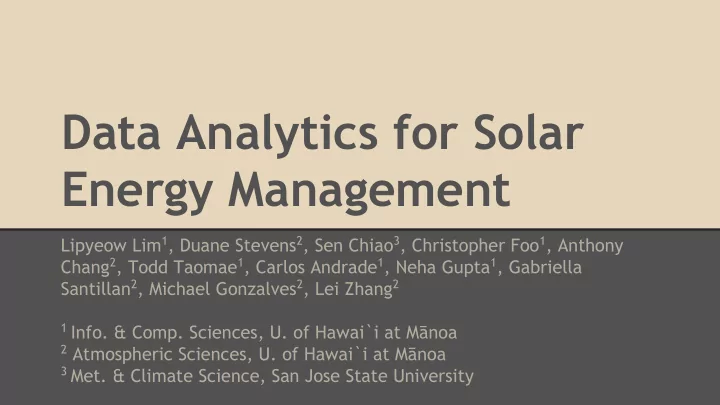

Data Analytics for Solar Energy Management Lipyeow Lim 1 , Duane Stevens 2 , Sen Chiao 3 , Christopher Foo 1 , Anthony Chang 2 , Todd Taomae 1 , Carlos Andrade 1 , Neha Gupta 1 , Gabriella Santillan 2 , Michael Gonzalves 2 , Lei Zhang 2 1 Info. & Comp. Sciences, U. of Hawai`i at Mānoa 2 Atmospheric Sciences, U. of Hawai`i at Mānoa 3 Met. & Climate Science, San Jose State University
Energy in the State of Hawai`i ● In 2013, Hawaii relied on oil for 70% of its energy. ● Hawaii’s electricity cost is 3 times the US average
Renewables in the State of Hawai`i Meet & exceed 70% clean energy by 2030
Disconnected Grids Six independent grids: Kauai, Oahu, Molokai, Lanai, Maui, Hawaii.
Research Objective Investigate the use of data-centric methods for predicting solar irradiance at a specific location ● complement not replace NWP (eg. WRF) ● 1-3 hour ahead predictions ● 1 day ahead predictions
Data Sources ● MesoWest 30 Weather Stations ○ ~10 sensors each ○ 5-60 min sampling ○ interval ● 4 Years of Hourly Data January 1, 2010 to ○ December 31, 2013 ● SCSH1, PLHH1 & KTAH1 stations
1-Hour Ahead Predictions ● Linear Regression ○ Select top-5 features from diff sensors at diff time at diff neighboring location ● Cubist Trees ○ Decision trees with linear regression models at the leaves ● Normalize data to hourly readings
Dealing with Seasonality Two types of cycles in the (irradiance) data: daily & yearly ● Separate models for each “season” ○ eg. a separate model for each month & hour: Jan 10am ● Deseasonalize the data ○ Mean signal: for each day & hour average the values over the 4 hours ○ Subtract the mean signal from the data
On a good day... Month-hour with top 5 features
Prediction Errors
1-3 Hour Ahead Predictions
1-Day Ahead Predictions ● Consider granularity of 1 day ● Apply a clustering algorithm k-means ○ ○ PAM ● Examine centroids / medoids
Partition Chains ● Procedure ○ Order partition numbers by date ○ Find consecutive days with the same partition number ○ Find the length of these “chains” ● Result:Normally about 2 ~ 3 consecutive days in the same partition Partition 1 Partition 2 Partition 3 Partition 4 Partition 5 Average 2.286 2.863 3.583 2.732 2.717 Chain Length Maximum 5 11 13 6 11 Chain Length
Partition Transitions
Conditional Probability 1 Day Before Next / Forecast Day Probability 15.38% 23.53% 26.70%
vs. Months
Naive Bayes Classifier ● Probabilistic classifier using Bayes’ theorem ○ Assumes independence between features ○ ● Feature Selection Relative Humidity, Temperature, Wind, Solar Clusters for target site ○ Greedy ○ ■ Select best number of clusters for each feature Find best combination of features ■
Setup ● 1 Day and 4 Day lead time ● 3 years training (2010 - 2012) ● 1 year testing (2013) ● PLHH1 & KTAH1 ● Hourly Top 5, 10, 20, 30, 50 features ○ 6 hour data window ○ ● Daily Conditional Probability & Naive Bayes ○ Predicting 6 solar irradiance partitions ■ ■ 2 day data window
WRF Comparison ● WRF Irradiance Forecasts ○ Run by Prof. Yi-Leng Chen of the Meteorology Department in SOEST ○ Freely available online ○ 3.5 Day Hourly Forecasts ○ 1.5 km resolution ● Find closest grid to stations ● Difference between forecasted and observed
Metric ● Mean Absolute Error = ● WRF & Hourly Forecasts ○ Predicted = Forecasted solar irradiance at the hour ○ Actual = Observed solar irradiance at the hour ● Daily Forecasts ○ Predicted / Actual solar irradiance values obtained from the cluster ● Only daytime hours (7 am - 8 pm) are considered
Data Driven vs. WRF - PLHH1
1 Day vs. 4 Days - PLHH1
“Rare” Events ● Similar to outlier analysis ● Several possible definitions depending on how we model what is NOT rare: ○ Infrequent events (phenomenological) ○ Events not predicted well by a given model (statistical or dynamical or both) ○ Events with high disagreement in an ensemble of models
GFS Rare Day: Dec 30, 2014 (- 0 days)
Conclusions ● 1-3H ahead forecasts ○ Linear Regression & Cubist Trees: ~15% error ● 1-3D ahead forecasts ○ Clustering into daily irradiance profiles ○ Interesting analysis using discrete techniques: chains, conditional entropy etc. ○ Discrete prediction techniques: ~15% error ● Outlier analysis ○ Incorporate “signal” from larger scale
vs. Temperature
1 Day vs. 4 Days - PLHH1
Data Driven vs. WRF - KTAH1
1 Day vs. 4 Days - KTAH1
1 Day vs. 4 Days - KTAH1
Recommend
More recommend